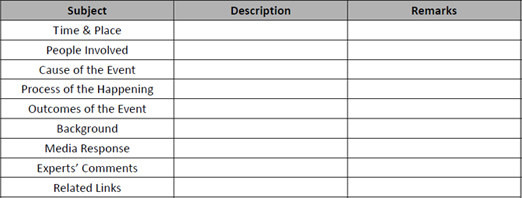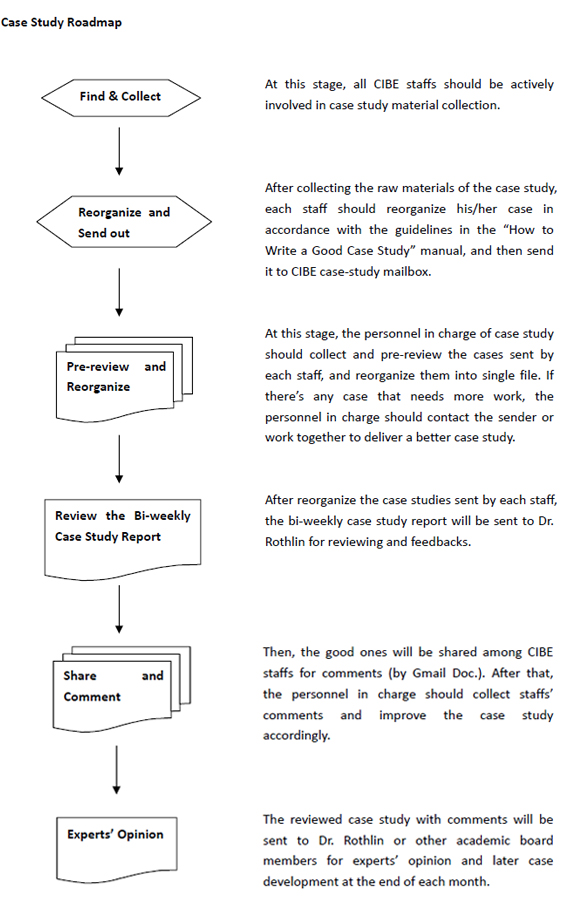What is a Case Study
A case study is a puzzle that has to be solved. The first thing to remember about writing a case study is that the case should have a problem for the readers to solve. The case should have enough information in it that readers can understand what the problem is and, after thinking about it and analyzing the information, the readers should be able to come up with a proposed solution. Writing an interesting case study is a bit like writing a detective story. You want to keep your readers very interested in the situation.
A good case is more than just a description. It is information arranged in such a way that the reader is put in the same position as the case writer was at the beginning when he or she was faced with a new situation and asked to figure out what was going on. A description, on the other hand, arranges all the information, comes to conclusions, tells the reader everything, and the reader really doesn't have to work very hard.
There are three basic steps in case writing: research, analysis, and the actual writing. You start with research, but even when you reach the writing stage you may find you need to go back and research even more information.
The Research Phase:
1. Internet and Library research. Find out what has been written before, and read the important articles about your case study. In this stage, you try to collect as much information about your case study as possible. The purpose is to have a comprehensive idea of what’s going on in the specific case.
2. Interview people who know the case or the situation. Find knowledgeable people to interview – they may be staffs within CIBE or they work in government offices or companies who’re familiar with your case study. The purpose of doing this is to get a clear mind of how things happened, who should be responsible and the connections behind each case. The problem of lacking certain information might emerge at this stage, you may want to go back to the first step. This stage is strong recommended, but if you have enough information to construct a logical case study, it can be skipped.
The Analysis Phase:
3. Put all the information in one place. Now you have collected a lot of information from people, from articles and books. You can't include it all. So, you need to think about how to sort through it, take out the excess, and arrange it so that the situation in the case will be understandable to your readers. Before you can do this, you have to put all the information together where you can see it and analyze what is going on.
4. Try to formulate the case problem in a few sentences. When you do this, you may find that you need more information. Once you are satisfied with the way you have defined the problem you want your readers to think about, break the problem down into all its parts. Each one represents a piece of the puzzle that needs to be understood before the problem can be solved.
The Writing Phase:
5. Describe the problem or case question you want the reader to solve. In a detective story, the crime happens right at the beginning and the detective has to put together the information to solve it for the rest of the story. In a case, you can start by raising a question.
6. Organize the sections of the case. You will probably need to organize your information under topics like the following:
1) Time and place of the case;
2) People involved in the case;
3) Causes of the case event;
4) The process of the case event;
5) The outcomes of such happenings;
6) Background description (Policies, Laws and regulation and etc.)
7) Media responses (with sources)
8) Experts Comments (with sources)
9) Related Links (with at least 3 links)
(The following table might be of some help in reorganizing the case information.)

Useful Web Links
Chinese:
1. Caijing Magazine: www.caijing.com.cn
2. Financial Times Chinese: http://www.ftchinese.com/sc/index.jsp
3. Economic Observer: http://www.eeo.com.cn/
4. Reuters Chinese: http://cn.reuters.com/
5. Wall-Street Journal Chinese: http://chinese.wsj.com/gb/
6. Other portal sites (Sina.com, Sohu.com,etc.)
English:
Global Times: http://www.globaltimes.cn/
China Daily: http://www.chinadaily.com.cn/
Business Ethics Website:
Globethics: http://chinese.wsj.com/gb/

The Division of Labor in Case Study Development
Each Staff:
1. Submit, at least, one case study report in accordance with “How to Write a Good Case Study” Manual every two weeks (Friday, every two weeks).
2. Comment on the shared cases (in one week after sharing the cases).
Personnel in Charge of Case Study (Robin or Mavis):
1. Collect and reorganize cases sent by each staff.
2. Share the good cases, picked by Dr. Rothlin, among staffs for comments.
3. Collect comments and draft the case study report.
4. Send the case study report to Dr. Rothlin or other academic board members for comments and later development.
|
